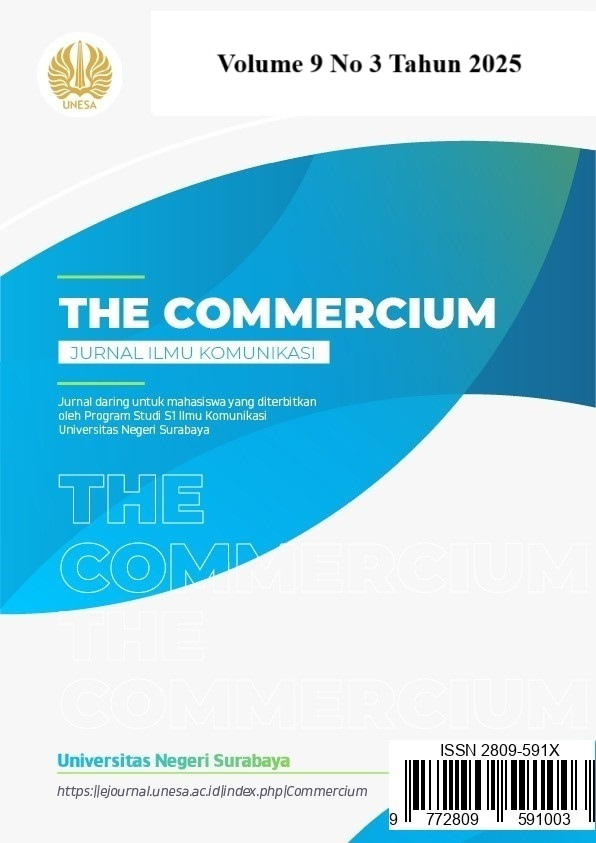Isu Middle Child Syndrome Pada Tokoh Aurora dalam Film Jalan yang Jauh Jangan Lupa Pulang (Analisis Semiotika Charles Sanders Peirce)
DOI:
https://doi.org/10.26740/tc.v9i3.72351Keywords:
Middle Child Syndrome, Semiotika, Charles Sanders Peirce, Representasi, Film.Abstract
Penelitian ini membahas representasi middle child syndrome dalam film Jalan yang Jauh Jangan Lupa Pulang melalui pendekatan semiotika Charles Sanders Peirce. Fokus utama terletak pada tokoh Aurora, anak tengah yang merasa kurang dihargai dalam keluarganya. Analisis terhadap simbol visual dan interaksi karakter menunjukkan bahwa Aurora tidak mendapatkan ruang untuk didengarkan, didukung, maupun diakui eksistensinya, baik oleh saudaranya maupun figur ayah. Ketimpangan ini tercermin dalam adegan-adegan kunci yang memperlihatkan isolasi emosional dan konflik internal Aurora akibar pola pengasuhan otoriter serta nilai-nilai patrialkal dalam struktur keluarga Asia. Penelitian ini menunjukkan bahwa film dapat menjadi medium reflektif untuk mengkritik dinamika keluarga yang hierarkis dan memperlihatkan realitas sosial anak tengah yang kerap terpinggirkan.
Downloads
References
DAFTAR PUSTAKA
Bhatt, S., & Khan, A. A. (2021). Helicopter parenting, self-efficacy and academic performance among college students. Journal of Psychiatry, 24(11), Article 487.
Blair, L. (2011). Birth order: What your position in the family really tells you about your character. Hachette UK.
Cayatoc, M. P., Cruz, J. A. P. Dela, Baluyut, J. B. P., Comia, K. D. G., Pe, J. C. D., Ruben, K. E. C., Capili, R. M. J., Ruiz, K. V. C., & Ulod, Y. G. (2021). Diagramming Mythical Reality: A Qualitative Analysis of Middle Children’s Identity Check, Phenomenology. International Journal of New Technology and Research, 7(12). https://doi.org/10.31871/ijntr.7.12.9
Chan, Katherine. (2023). Is Middle Child Syndrome Real? Verywell Mind. https://www.verywellmind.com/is-middle-child-syndrome-real-7410121
Chandler, D. (2007). The Basics: Semiotics (Second Edition). Taylot & Francis E-Library.
Creswell, J. W., & Creswell, J. D. (2017). Research Design: Qualitative, Quantitative, And Mixed Methods Approaches. Sage Publications002E
Fukuya, Y., Fujiwara, T., Isumi, A., Doi, S., & Ochi, M. (2021). Association of Birth Order With Mental Health Problems, Self-Esteem, Resilience, and Happiness Among Children: Results From A-CHILD Study. Frontiers in Psychiatry, 12(April), 1–15. https://doi.org/10.3389/fpsyt.2021.638088
Suci, H. (2023). The Impact of Birth Order and Parenting Style on Sibling Rivalry Among Pre-school children. Journal of Health Sciences and Epidemiology, 1(3), 109–115. https://doi.org/10.62404/jhse.v1i3.28
Ley, D., & Cybriwsky, R. (1974). Urban Graffiti as territorial Markers. ANNALS of the Association of American Geographers, 64(4), 491–505.
Mejares, A. C., Allan, C., Suemith, A., Kaye, N., Adtoon, C., & Stephany, M. (2024). Cast no shadow : a phenomenological study of a middle child. Penrose: International Journal of Interdisciplinary Studies, 1(1), 1–6.
Park, M., & Chesla, C. (2007). Revisiting Confucianism as a Conceptual Framework for Asian Family Study. Journal of Family Nursing, 13(3), 293–311. https://doi.org/10.1177/1074840707304400
Ridley, D. (2012). The Literature Review: A Step-By-Step Guide For Students. SAGE Publications.
Sulloway, Frank J. (1996). Born to rebel: Birth order, family dynamics, and creatives lives. Pantheon Books.
Subroto, U., Sattydarma, Monty P.., & Wati, Linda. (2017). Pengaruh Urutan Kelahiran pada Kecemasan Mahasiswa Sekolah Tinggi Ilmu Komunikasi X Jakarta. Jurnal Muara Ilmu Sosial, Humaniora, dan Seni, 1 (1), 311-318.
Zaichenko, S. (2019). FILM DISCOURSE AS A POWERFUL FORM OF MEDIA AND ITS MULTI-SEMIOTIC FEATURE. Future Academy.
Downloads
Published
How to Cite
Issue
Section
 Abstract views: 67
,
Abstract views: 67
, PDF Downloads: 71
PDF Downloads: 71

